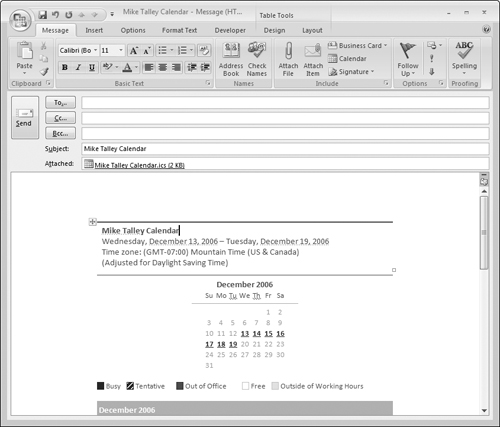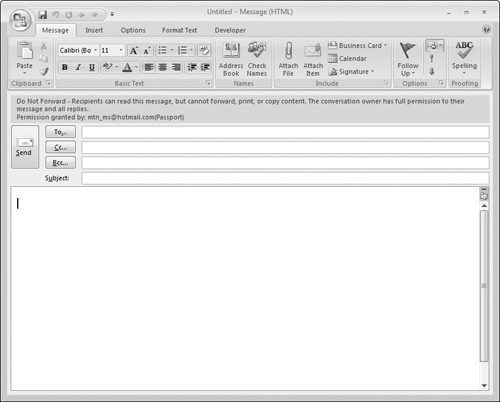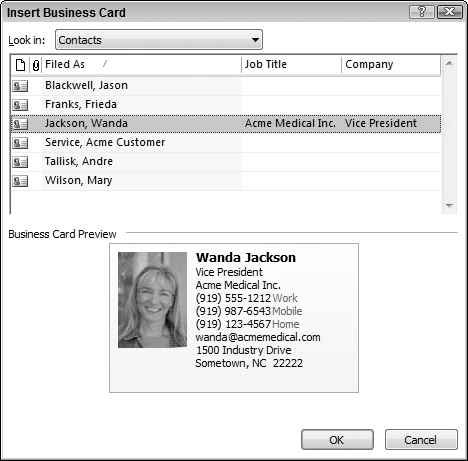Setting Options for an Individual E-Mail Message
Although you can create and send e-mail messages using all of Outlook’s default settings, you would be missing a lot of flexibility and convenience if you did so. The various e-mail options that Outlook offers let you use e-mail in the way that is most convenient and productive for you. These options fall into two categories: those that apply to a single message and those that apply globally. This section explains a variety of options available for individual e-mail messages that you create.
Changing the send account
This topic is relevant only if you have two or more e-mail accounts. By default, messages are sent as follows:
Messages you create from scratch are sent using the default e-mail account.
Messages that are replies to a message you received are sent using the account through which the original message was received.
Messages you forward are sent using the account through which the original message was received.
To change the send account for a message:
1. | Click the Account button on the Message tab of the Ribbon. A menu is displayed with the current send account checked. |
2. | Select the desired account from the menu. |
Saving sent items
By default, e-mail messages that you send are saved in the Sent Items folder. You can change this location for an individual message as follows:
1. | Click the Save Sent Item button on the Options tab of the Ribbon. |
2. | To save the item to a folder other than the default, click Other Folder and then select the folder. |
3. | To not save the item at all, click Do Not Save. |
Sending items with a message
You learned earlier how you can attach a file to a message. Outlook also lets you attach certain items, specifically calendars and business cards, to a message.
Sending a calendar
Sending calendar information with a message can be useful to let colleagues know when you are and are not available for a meeting. To send calendar information with an e-mail message, click the Calendar button in the Include section of the Message tab on the Ribbon. Outlook displays the Send a Calendar via E-Mail dialog box, shown in Figure 27-40. You make entries in this dialog box to specify the calendar information that will be sent, as follows:
1. | If you have more than one calendar, select the calendar to use from the Calendar list. |
2. | Select the date range from the Date range list. Predefined ranges include today, tomorrow, and the next 7 days. Select Specify Dates from the list to enter a custom date range. |
3. | From the Detail list, select the level of calendar detail that you want included in the message. The choices are the following:
|
4. | Select the Show Time Within My Working Hours Only option to limit the sent calendar information to these hours. By default, they are 8:00 a.m. to 5:00 p.m. Monday–Friday. Click the Set Working Hours link to change this setting. |
5. | Click the Show button to display three additional options. Two of them relate to what information is included in the message. These options are relevant only if you selected Limited Details or Full Details. The third option determines the format of the sent calendar: Daily Schedule or List of Events. See the main text for information on these two layouts. |
6. | Click OK to close the dialog box and insert the calendar information in the message. |
Figure 27-40. Sending calendar information in an e-mail message.

When calendar information is inserted in an e-mail message, at the top is a calendar of the month or months involved with the relevant days highlighted and underlined, as shown for July 13–19 in Figure 27-41. The recipient can click these days to go to the detail section for that day.
Figure 27-41. This part of the calendar information includes links to individual days.

If the calendar information was sent using the Daily Schedule option, the details appear as shown in Figure 27-42. You can see that blocks of time during each day are marked as free, busy, and so on.
Figure 27-42. Display of calendar details when the Daily Schedule option is used to send the calendar.

If the calendar information was sent using the List of Events option, the message lists specific calendar events only—free time is not explicitly marked.
Sending a business card
A business card is just what it sounds like—an electronic representation of the information normally found on a paper business card. Every entry in a contacts list automatically has a business card created for it. You can insert these cards into e-mail messages to send contact information to e-mail recipients. When you do so, a visual representation of the business card is added to the message and a VCF file is attached to the message. The recipient can use the VCF file to quickly add the contact information to his or her own Contacts list.
To send a business card with an e-mail message:
1. | Click the Business Card button in the Include group of the Message tab on the Ribbon. The menu that is displayed lists recently sent business cards. |
2. | Select the card you want to send, or select Other Business Cards to select from your Contacts list. |
3. | If you selected Other Business Cards, Outlook displays the Insert Business Card dialog box, as shown in Figure 27-43. Figure 27-43. Selecting a business card to include in an e-mail message.
|
4. | If you have more than one address book, select the desired one from the Look In list. |
5. | Click the contact whose business card you want to include. The card is previewed in the lower part of the dialog box. |
6. | If you want to include more than one card, hold down Ctrl while clicking. |
7. | Click OK. |
Your Own Business CardIf you create an entry for yourself in your Contacts list, you can send your own business card with e-mail messages. |
Setting message importance and sensitivity
An e-mail message can be flagged as having low importance or high importance. Low is the default. The recipient’s e-mail program may indicate the importance of a message in some way. For example, Outlook displays an exclamation point next to the message in the Inbox if it is marked as having high importance. Many e-mail clients, including Outlook, also allow recipients to sort their received messages by importance.
To mark a message with high importance, click the High Importance button (a red exclamation point) in the Options section of the Message ribbon. To return a message to the default setting of low importance, click the Low Importance button (a downward-pointing arrow).
Setting message restrictions
Message restrictions, or permissions, let you restrict who can view your e-mail messages and what they can do with them (for example, can the message be forwarded?). This feature, which is applicable to all Office documents as well as e-mail messages, is part of Information Rights Management, or IRM.
IRM is based on the concept of credentials. To create rights-restricted content, such as an e-mail message, you must possess appropriate credentials to associate with the message. The recipient must also possess the appropriate credentials to view or take other actions with the content.
IRM requires that both the creator and the recipient of restricted content be subscribed to an IRM server. Many people use the Windows Right Management (WRM) service, which at present is free (but with no guarantee that Microsoft will continue the service indefinitely). WRM uses .Net Passport as a means of verifying identities and validating credentials. Some companies use their own IRM server or one provided by a third party.
The steps described in this section assume that you have a rights management client installed on your computer and have set up the necessary credentials.
By default, e-mail messages are created with no restrictions. You can add a Do Not Forward restriction by clicking the Permissions button on the Message ribbon and selecting Do Not Forward from the menu. This button is displayed only if you are set up for IRM. This restriction permits recipients to view the message if they have the required credentials, but not to forward, print, or copy the message.
You may be asked which credentials to use for this message (an individual can possess multiple credentials). When a message you are composing is restricted, it displays a banner below the Ribbon describing the restrictions, as shown in Figure 27-44.
Figure 27-44. A message that has restrictions applied displays a notification of that fact below the Ribbon.

If you attach a document, workbook, or presentation to a message, the restricted permissions of the message are applied to the attachments as well. If the attachment has already had restrictions set in the originating program (Word, Excel, or PowerPoint), those restrictions also remain in effect.
You may also have custom restrictions available to you. In a company, the IT department may have defined a restriction level that restricts contents to people on the company network. Your IT person can provide you with information on custom restrictions if they are in use in your organization.
Flagging a message for follow-up
Sometimes, when you send a message, you would like to be reminded to follow up on the message—for example, to make sure that you have received a reply. You can flag a message for follow up and, optionally, have Outlook remind you. Here’s how:
1. | Click the Follow Up button on the Message tab of the Ribbon. Outlook displays the menu shown in Figure 27-45. |
2. | To flag for follow up at one of the predefined times (for example, tomorrow or next week), choose the corresponding command on the menu. |
3. | To specify a custom time, choose the Custom command. Outlook displays the Custom dialog box, as shown in Figure 27-46. Figure 27-46. Specifying a custom follow-up interval.
|
4. | Make sure that the Flag for Me option is selected. |
5. | From the Flag To list, select the type of follow up (for example, Follow Up, Reply, and so on). |
6. | Enter the desired start and due dates in the corresponding fields. Click the down arrow next to each field to select from a calendar. |
7. | If you want Outlook to remind you of this item, select the Reminder option and then enter the date and time in the adjacent fields. |
8. | Click OK. |
You can also flag a message for the recipient. All you need to do is select Flag for Recipients from the Follow Up menu (Figure 27-45) and then enter the relevant information in the lower part of the Custom dialog box (Figure 27-46).
When an Outlook user receives a message with such a flag, the flag status column in the Inbox displays a special icon indicating that follow up information is included with the message. The user can right-click this icon to add the message to his or her to-do list. E-mail programs other than Outlook may ignore this information or handle it differently.
Assigning a message to a category
Outlook’s categories are a powerful tool for organizing all kinds of information. When you create a message, you can assign it to a category. Then you can find the message—the saved copy of the sent message, that is—based on this category. To assign a category to a message:
1. | Click the Dialog Box Launcher in the More Options group of the Options tab on the Ribbon to display the Message Options dialog box. |
2. | At the lower left of the dialog box, click the Categories button. |
3. | Select the desired category from the menu. Or, click Clear All Categories to remove any category assignment from the message. |
Requesting delivery and read receipts
When you send a message, you can request delivery or read receipts (or both) by selecting the corresponding option in the Tracking group of the Options tab of the Ribbon. A delivery receipt is generated when the message is delivered to the recipient, and a read receipt is generated when the message is opened by the recipient. The receipt consists of an e-mail message back to you that contains the date and time that the original message was delivered or read.
Delivery and read receipts sound like a great idea but their usefulness in practice is limited. The delivery receipt must be generated by the e-mail server software, and sometimes this feature is turned off by the server administrator to reduce the load on the server. Even if you do receive a delivery receipt, there is no guarantee that the recipient has read the message. Likewise, the read receipt is sent by Outlook (or whatever other e-mail program the recipient is using), and the user may have this feature turned off.
When you have sent a message and requested a receipt, Outlook automatically processes the receipt when and if it arrives (unless you have turned this feature off under Tracking Options, as explained later in this chapter). When you open the message in the Sent Items folder, the Message tab of the Ribbon displays a Show group with Message and Tracking buttons (Figure 27-47). Click the Tracking button to view the details of any receipts that have been received for this message. Click the Message button to return to the message text.
Be aware that if Outlook has not yet received and processed any receipt for a message, the Tracking button is not available on the Message tab of the Ribbon.
Delaying delivery
If you do not want a message delivered right away, you can specify a “do not deliver before” date, as follows:
1. | Click the Delay Delivery button in the More Options group of the Options tab of the Ribbon. Outlook displays the Message Options dialog box (Figure 27-48). |
2. | In the Delivery Options section, select the Do Not Deliver Before option. |
3. | Enter the desired date and time in the adjacent fields. |
4. | Click the Close button. |
If you are using a Microsoft Exchange e-mail account, the message is sent to the server and held there until the specified date and time. If you are using another kind of e-mail account, the message is held in Outlook’s outbox until the first send operation that occurs after the specified date and time.
Setting a message expiration date
If you are sending a message that is relevant for only a limited period, you can set an expiration date for the message. When the recipient receives the message, that message will behave normally until the expiration date, after which it will display in the Inbox (or whatever folder it is in) with a line through the header. The recipient can still open the message, but the strikethrough provides a visual indication that the message has expired. Other e-mail programs may handle message expiration differently.
To set an expiration date:
1. | Click the Dialog Box Launcher in the Options group of the Message tab of the Ribbon. Outlook displays the Message Options dialog box (shown previously in Figure 27-48). |
2. | In the Delivery Options section of the dialog box, select the Expires After option. |
3. | Enter the desired expiration date and time in the adjacent fields. |
4. | Click Close. |





